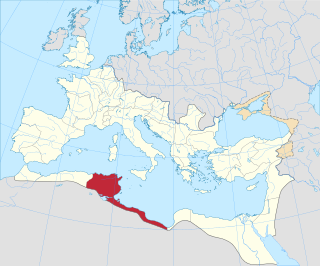Related Research Articles

Quaestoriana was an ancient civitas (town) and bishopric in Roman Byzacena(North Africa). Quaestoriana is also a suppressed and titular see of the province of Byzacena in the Roman Catholic Church. The current bishop is Manuel Antonio Valarezo Luzuriaga. Its present location is in modern Tunisia.

Menefessi is a former ancient city and bishopric in Tunisia. It is currently a Latin Catholic titular see.

Decoriana was an ancient Roman–Berber city and former bishopric in Tunisia. It is now a Latin Catholic titular see.

Turrisblanda, was a Roman and Byzantine era colonia (town) in the Roman Empire province of Byzacena in what is today modern Tunisia. Its exact location remains unknown. It was also a capital of an historic diocese of the Roman Empire. The bishopric remains today as a titular see of the Roman Catholic Church. The current bishop is Jan Szkodoń, Auxiliary Bishop of Cracow.

Aeliae or Æliæ was a Roman-era city in the province of Byzacena.

Thagamuta was a Roman–Berber city in the province of Byzacena. The location of the town is not definitively known, but it was on the plain of Guemouda in modern Tunisia.

Auzegera was a Roman-Berber town in the province of Africa Proconsularis and in late antiquity Byzacena. It was a Catholic Church diocese.

Autenti was a Roman–Berber civitas and bishopric in Africa Proconsularis. It was a diocese of the Roman Catholic Church.

Cufruta was an ancient Roman-Berber civitas in the province of Byzacena. It was also the seat of a Roman Catholic diocese.

Forontoniana was a Roman town of the Roman province of Byzacena during late antiquity. The town has tentatively been identified with the ruins at Henchir-Bir-El-Menadla in modern Tunisia.

Muzuca was a Roman Town of the Roman province of Byzacena during late antiquity. The town has tentatively been identified with the ruins at Henchir-Besra in modern Tunisia. Very little is known of the city, though in situ epigraphical evidence gives us the name and that in late antiquity it achieved the status of Municipium.

The Diocese of Mozotcori is a home suppressed and titular see of the Roman Catholic Church.

Precausa was an ancient civitas of the Roman province of Byzacena in North Africa. Its exact location remains unknown but it was in the present Sahel region of Tunisia.

Scebatiana was an ancient civitas of the Roman Province of Byzacena during the Roman Empire and late antiquity. The exact location of the town is unknown, but is thought to be somewhere in southern Tunisia.

Gratiana was an ancient city and bishopric in Roman Africa, which remains a latin catholic titular see.

Octaba was an ancient Roman–Berber city in the province of Africa Proconsularis and Byzacena in late antiquity. Its exact location is now lost, but it was in the Sahel region of Tunisia. In 484AD the town's Catholic bishop, Sabinico, attended a synod in Carthage called by the Arian king Huneric, the Vandal. At the conclusion of that synod, Sabinico was sent into exile by the king.
Sicilibba was an ancient Roman town of the Roman province of proconsular Africa. The ancient town is tentatively identifiable with the ruins at Alaouine in today's Tunisia.

The diocese of Tetci is a suppressed and titular see of the Roman Catholic Church. An exact location of the town is now lost to history but it was in today's Tunisia.

The diocese of Maraguia is a suppressed and titular see of the Roman Catholic Church.

The Diocese of Sassura is a suppressed and titular see of the Roman Catholic Church. The Roman Town of Sassura, identifiable with Henchir-Ez-Zaouadi in today's Tunisia, is the ancient episcopal seat of the diocese which was in the Roman province of Byzacena.